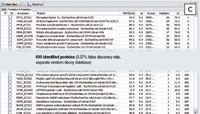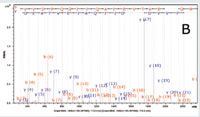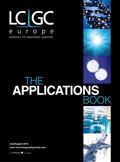Enhanced Peptide Identification with an Ultra High Resolution Mass Spectrometer
The Application Notebook
Analysis of biological samples frequently involves the identification of peptides from low amounts of complex samples. Confident identification of these peptides requires rapid generation of high quality, high sensitivity MS and MS–MS data. The maXis TOF mass spectrometer incorporates novel technical innovations, which together produce an unprecedented level of data quality, resulting in a significant increase in the number of peptides identified from challenging samples.
Laura C. Main and Ralf Ketterlinus, Bruker Daltonik, Bremen, Germany.
Introduction
For complex samples, resolution is required from both the LC and the mass spectrometer. Modern day LC systems exploit rapid LC gradients that offer increased speed of analysis. Very narrow peak widths are produced, commonly only 1 sec wide compared to 30 sec with a standard LC. This effectively increases the peptide concentration reaching the mass spec and, therefore, results in increased sensitivity. It is however, essential that the mass spec duty cycle is fast enough to detect these peaks as they rapidly emerge from the LC system and that enough data points are acquired from each peak profile, particularly if quantification is desired.
Experimental
Complex sample: 100 ng of E. coli cells. Low abundance sample: 500 amol Bovine serum albumin (BSA). Both samples were digested with trypsin.
LC systems and gradients: Ultimate 3000 (Dionex) and EASY-nLC (Bruker). Gradient: from 5 to 40% ACN, 0.1% formic acid, in 90 min (E. coli.) or 10 min (BSA), flow rate 300 nL/min. Analytical column: 75 µm × 150 mm, trapping column, 100 µm × 10 mm; Acclaim PepMap100 C18 (Dionex).
MS system: Bruker Daltonics maxis ultra high resolution TOF.
Results
Complex sample: From 100 ng of digested E. coli cells, 690 proteins were identified with a stringent false positive detection rate of 0.57% (Figure 1). 8507 spectra were acquired and searched by Mascot 2.2. The Swissprot 56.1 database was used, with taxonomy restricted to E. coli. The modifications included were carbamidomethyl Cys (fixed) and oxidized Met (variable).

Figure 1: ProteinScape screenshot of protein list (start and end). 690 proteins were identified from 100 ng digested E. coli cells.
4917 peptides matched the identity threshold with an average Mascot score of 58.8. Thus, over 58% of MS–MS spectra were identified as significant — demonstrating the high quality of the MS–MS data produced. See Figure 2 as an example.

Figure 2: Example fragment spectrum delivering high sequence coverage.
Low abundance samples: From 500 amol BSA, 13 unique peptides were identified, representing a sequence coverage of 23% and an overall Mascot scoring of 412 (Figure 3). Here, taxonomy was restricted to mammals. Again, peptides were confidently identified based on high quality MS–MS data.

Figure 3: Fragment spectrum from a 500 amol BSA digest.
Hence, these results prove maXis' capability to provide high MS resolving power to separate potentially overlapping signals in a complex sample and, therefore, to allow correct mass assignments. Ultimately, these features directly translate into high identification rates with excellent Mascot scores — even on a time scale that keeps pace with modern ultrafast LC systems.1
Conclusion
The key proteomics goals are identifying more peptides with more certainty. The maXis ultra high resolution TOF mass spectrometer brings together novel design technologies to reach these goals. The technological advances include a hexapole collision cell together with an ion cooler which provide efficient fragmentation of ions from a broad mass range and efficient transfer of fragment ions from the collision cell into orthogonal acceleration. In addition, techniques have been employed to reduce energy distribution in the direction of flight and to ensure a precise starting position for orthogonal deflection.
In combination, these technical developments result in high quality, information rich spectra at high resolution (40000) with incredible mass accuracy (low to sub ppm) at the MS and MS–MS level along with fast acquisition speeds. A substantial increase in the number of peptides identified from both complex and low abundance samples with an increase in significance and certainty for the peptides identified has been demonstrated.
Reference
1. Bruker Daltonics Application Note ET-16.
Bruker Daltonik GmbH

Fahrenheitstr. 4, 28359 Bremen, Germany
tel. +49 421 2205 0 fax +49 421 2205 104
E-mail: sales@bdal.de
Website: www.bdal.com















